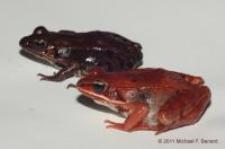Sep 29 2014
Scientists have found amphibians worldwide are breeding earlier due to climate change, but how that affects species is just now being answered.
 After warm winters, wood frogs in the wild breed earlier and produce fewer eggs. Credit: Mike Benard
After warm winters, wood frogs in the wild breed earlier and produce fewer eggs. Credit: Mike Benard
After warmer winters, wood frogs breed earlier and produce fewer eggs, a Case Western Reserve University researcher has found.
Michael F. Benard, the George B. Mayer Chair in Urban and Environmental Studies and assistant professor of biology, also found that frogs produce more eggs during winters with more rain and snow.
Benard's study, published today in the journal Global Change Biology, is among the first in a natural habitat to measure the consequences of one of the major effects of climate change: warmer temperatures that lead to earlier breeding in amphibians and other animals.
Benard also found that when wood frogs breed early in the year, their offspring have delayed development but still metamorphose earlier in the year. He identified the broad patterns by examining and tracking important life events of more than 50,000 juvenile and hundreds of adult wood frogs over seven years and comparing the data to winter weather records.
"There have been lab studies on the effects of warming on frog breeding, but what we see in the lab is not exactly what we're seeing in the field," Benard said.
Wood frogs, found from Alabama to Alaska, literally must thaw out from winter. Biologists believe they breed after temperatures and precipitation reach a certain threshold over a number of days. But the exact formula is unknown. During breeding, each female lays all of her eggs in one mass, called a clutch, which makes egg-counting possible.
After analyzing data collected from 2006 to 2012, Benard found that for every degree Celsius increase in average daily maximum winter temperature:
- Wood frogs bred 4.2 days earlier.
- The number of eggs per clutch collected in the ponds decreased 3.3 percent, or 24 eggs.
- The number of eggs per clutch collected from frogs that had been marked and placed in buckets of water to breed decreased 4.3 percent, or 31 eggs.
"The decrease in eggs per clutch is likely due to increased energy consumption by the females during warmer winters," Benard explained.
The frogs produce a kind of anti-freeze that prevents their cells from freezing. But the fluid between cells freezes, and the animals' heartbeat and breathing halts in subzero temperatures. If frogs stay frozen longer, their metabolism is greatly reduced.
Opposite to warming, more rain and snow appear to have a positive effect on egg production. For every 2.5-centimeter increase in total precipitation, the number of eggs per clutch increased 2.3 percent, or 16.5 eggs. The reason is uncertain, but with climate change expected to increase rainfall in some regions, the effect may help counter potential losses associated with warming.
Benard found no effect of breeding date on tadpole survival or their size at metamorphosis. But earlier breeding was associated with delayed tadpole development due to a counter-intuitive effect of warmer winters on the temperatures that tadpoles experience. It turns out that although earlier breeding is triggered by warmer winters, when breeding occurs earlier, the pond water in which tadpoles develop is colder than if breeding took place in later spring. Colder water likely slowed the advancement from egg to metamorphosis.
Although tadpole development was slowed, for every two days earlier that breeding took place, metamorphosis was a day earlier.
"Earlier metamorphosis potentially increases survivorship," Benard said. "Other studies have found that, after a longer summer growth period, amphibians were larger come winter and had better chances of surviving the cold, predators and disease.
"I'm not sure that's the case here," he said. "That will take more study."
Benard was a fellow in the University of Michigan's Society of Fellows when he began the study at six ponds in the university's E.S. George Reserve, a 1,300-acre research station in southeastern Michigan. Temperatures were recorded by a nearby weather station.